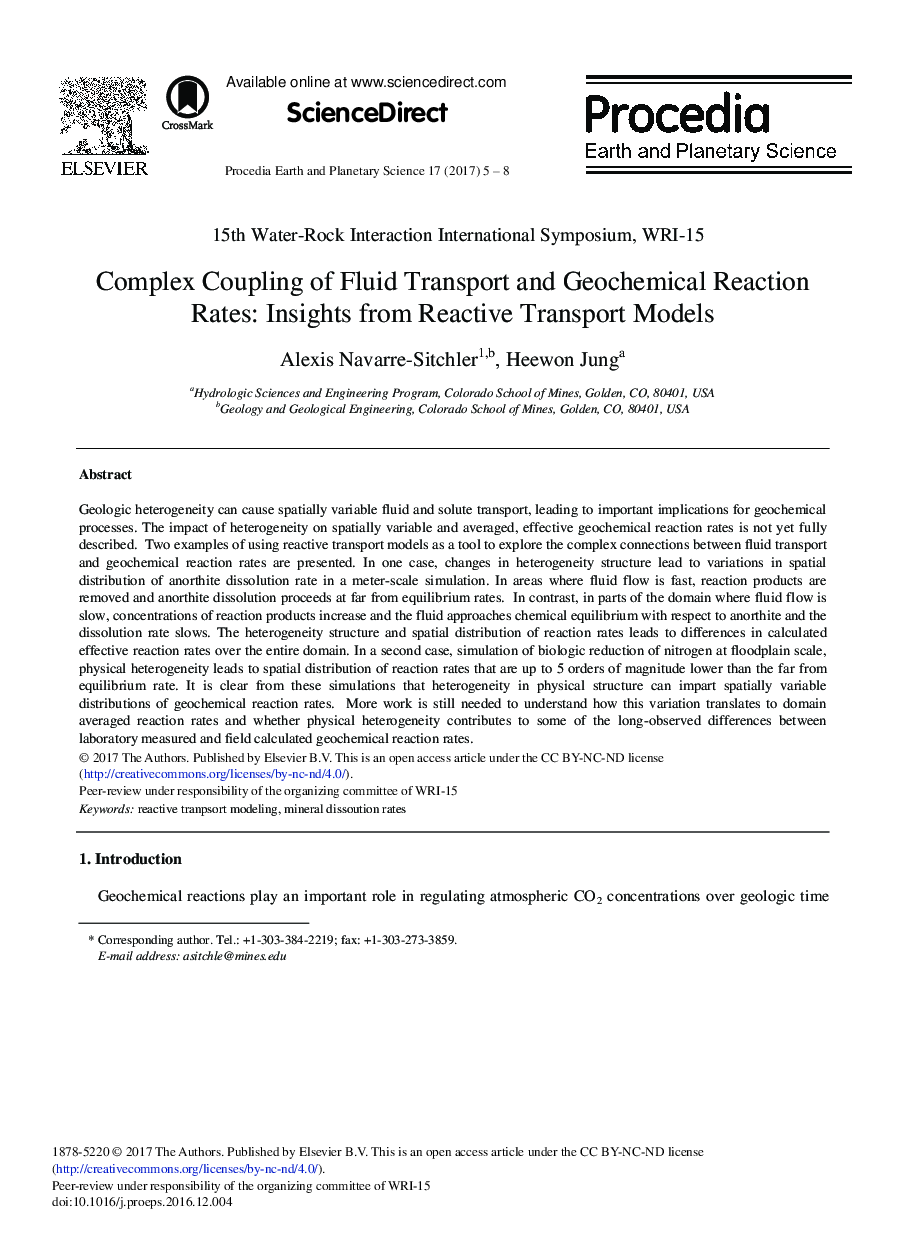| کد مقاله | کد نشریه | سال انتشار | مقاله انگلیسی | نسخه تمام متن |
|---|---|---|---|---|
| 5779220 | 1634387 | 2017 | 4 صفحه PDF | دانلود رایگان |
عنوان انگلیسی مقاله ISI
Complex Coupling of Fluid Transport and Geochemical Reaction Rates: Insights from Reactive Transport Models
ترجمه فارسی عنوان
اتصال پیچیده حمل و نقل سیال و نرخ واکنش های ژئوشیمیایی: بینش از مدل های حمل و نقل واکنش
دانلود مقاله + سفارش ترجمه
دانلود مقاله ISI انگلیسی
رایگان برای ایرانیان
کلمات کلیدی
مدل سازی تریپسور واکنش پذیر، میزان تخریب مواد معدنی،
ترجمه چکیده
ناهمگنی زمین شناسی می تواند باعث انتقال مایع و محلول محلول متغیر شود و منجر به پیامدهای مهم برای فرایندهای ژئوشیمیایی شود. تاثیر ناهمگنی بر متغیرهای فضایی و متوسط، سرعت واکنش ژئو شیمیایی هنوز مشخص نشده است. دو مثال از استفاده از مدل های حمل و نقل واکنشی به عنوان یک ابزار برای کشف ارتباطات پیچیده بین انتقال سیال و سرعت واکنش ژئوشیمیایی ارائه شده است. در یک مورد، تغییر ساختار ناهمگونی منجر به تغییرات در توزیع فضایی سرعت انحلال انوریت در یک شبیه سازی مقیاس متر می شود. در مناطقی که جریان مایع سریع است، محصولات واکنش حذف می شوند و انحلال آنوراتیت به میزان زیادی از میزان تعادلی ادامه می یابد. در مقابل، در قسمت هایی از دامنه ای که جریان مایع آهسته است، غلظت محصولات واکنش افزایش می یابد و مایع با تعادل شیمیایی نسبت به آنورتیت افزایش می یابد و میزان انحلال کاهش می یابد. ساختار ناهمگن و توزیع فضایی سرعت واکنش منجر به تفاوت در نرخ بازده موثر در کل دامنه می شود. در مورد دوم، شبیه سازی کاهش بیولوژیکی نیتروژن در مقیاس سیلاب، ناهمگونی فیزیکی منجر به توزیع فضایی سرعت واکنش می شود که تا 5 مرتبه پایین تر از دور از حد تعادلی است. از این شبیه سازی ها روشن است که ناهمگنی در ساختار فیزیکی می تواند توزیع متغیرهای متغیر سرعت واکنش ژئو شیمیایی را به ارمغان بیاورد. هنوز کار بیشتر لازم است تا بدانیم که چگونه این تغییرات به میزان واکنش میانگین واکنش تبدیل می شود و اینکه آیا ناهمگونی فیزیکی به برخی از تفاوت های طولانی بین آزمایش های اندازه گیری شده و نتایج واکنش های ژئو شیمیایی محاسبات محاسبه شده است.
موضوعات مرتبط
مهندسی و علوم پایه
علوم زمین و سیارات
علم هواشناسی
چکیده انگلیسی
Geologic heterogeneity can cause spatially variable fluid and solute transport, leading to important implications for geochemical processes. The impact of heterogeneity on spatially variable and averaged, effective geochemical reaction rates is not yet fully described. Two examples of using reactive transport models as a tool to explore the complex connections between fluid transport and geochemical reaction rates are presented. In one case, changes in heterogeneity structure lead to variations in spatial distribution of anorthite dissolution rate in a meter-scale simulation. In areas where fluid flow is fast, reaction products are removed and anorthite dissolution proceeds at far from equilibrium rates. In contrast, in parts of the domain where fluid flow is slow, concentrations of reaction products increase and the fluid approaches chemical equilibrium with respect to anorthite and the dissolution rate slows. The heterogeneity structure and spatial distribution of reaction rates leads to differences in calculated effective reaction rates over the entire domain. In a second case, simulation of biologic reduction of nitrogen at floodplain scale, physical heterogeneity leads to spatial distribution of reaction rates that are up to 5 orders of magnitude lower than the far from equilibrium rate. It is clear from these simulations that heterogeneity in physical structure can impart spatially variable distributions of geochemical reaction rates. More work is still needed to understand how this variation translates to domain averaged reaction rates and whether physical heterogeneity contributes to some of the long-observed differences between laboratory measured and field calculated geochemical reaction rates.
ناشر
Database: Elsevier - ScienceDirect (ساینس دایرکت)
Journal: Procedia Earth and Planetary Science - Volume 17, 2017, Pages 5-8
Journal: Procedia Earth and Planetary Science - Volume 17, 2017, Pages 5-8
نویسندگان
Alexis Navarre-Sitchler, Heewon Jung,
